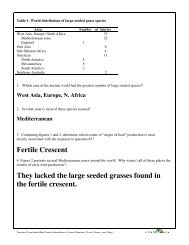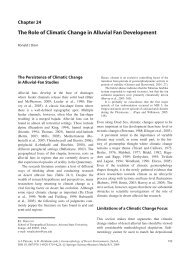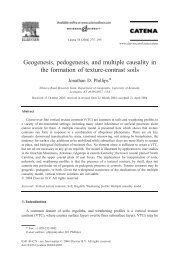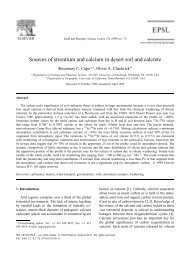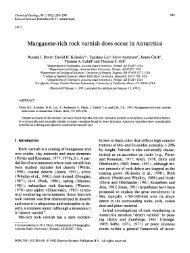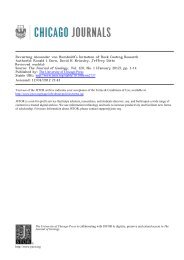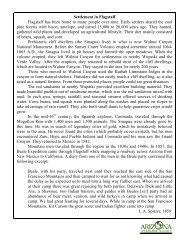Dorn, R. 2004. Experimental approaches to dating petroglyphs
Dorn, R. 2004. Experimental approaches to dating petroglyphs
Dorn, R. 2004. Experimental approaches to dating petroglyphs
Create successful ePaper yourself
Turn your PDF publications into a flip-book with our unique Google optimized e-Paper software.
<strong>Experimental</strong> Approaches <strong>to</strong> Dating Petroglyphs and Geoglyphs with Rock Varnish in the California Deserts:<br />
Current Status and Future Directions<br />
Figure 6. Lead profile <strong>dating</strong> of prehis<strong>to</strong>ric <strong>petroglyphs</strong> from Legend Rock in Wyoming, Coso Range in California, and Deer) Valley,<br />
Arizona (left) and his<strong>to</strong>ric surfaces in Arizona and California (right).<br />
Lead profile <strong>dating</strong> can be performed with different<br />
analytical instruments, such as the electron microbe and<br />
laser inductively coupled plasma instruments. No matter the<br />
technique, this method can help discriminate <strong>petroglyphs</strong><br />
that pre-date anthropogenic pollution. Thus, if you are faced<br />
with a debate over whether a petroglyph is his<strong>to</strong>ric graffiti or<br />
prehis<strong>to</strong>ric, lead profile <strong>dating</strong> may be able <strong>to</strong> determine<br />
whether or not an engraving pre-dates the extensive use of<br />
lead in au<strong>to</strong>motive fuels and other sources of lead pollution.<br />
DATING ORGANIC CARBON ASSOCIATED WITH<br />
PETROGLYPHS<br />
Radiocarbon Dating<br />
My call for and participation in (Loendorf 1991) blind<br />
testing of rock art <strong>dating</strong> methods led me <strong>to</strong> participate in the<br />
first and only blind testing of petroglyph radiocarbon <strong>dating</strong><br />
with A. Watchman, conducted by Portuguese authorities in<br />
1995 on <strong>petroglyphs</strong> in the Côa Valley, Portugal (Bednarik<br />
1995). Watchman and I both obtained statistically identical<br />
mid-Holocene radiocarbon ages for the Côa engravings<br />
(Bednarik 1995 , <strong>Dorn</strong> 1997, Watchman 1996).<br />
Watchman provides accurate details in 1997:<br />
Although [<strong>Dorn</strong> and Watchman's] methods<br />
of sampling Coa <strong>petroglyphs</strong> were different<br />
the compositions of the components dated<br />
were essentially the same. Rock chips of<br />
surface accretions and weathering rinds<br />
taken from <strong>petroglyphs</strong> contain “organic<br />
matter” of two types: modern<br />
216<br />
microorganisms, charcoal and pollen debris<br />
in the soft surface accretions and finegrained<br />
crystalline old graphite from the<br />
subsurface weathering rinds. Dates on<br />
separate fractions of these components give<br />
dates reflecting modern and old carbon<br />
(almost 30,000 years), but mixtures of the<br />
two components give results that average<br />
about 4500 years (Watchman 1997: 7)<br />
Still, two very different interpretations of these results<br />
followed. I argued at the May 1996 American Rock Art<br />
Research Association meetings that radiocarbon <strong>dating</strong> of<br />
<strong>petroglyphs</strong> does not work (Welsh and <strong>Dorn</strong> 1997); similar<br />
statements were made in other venues (<strong>Dorn</strong> 1996a; <strong>Dorn</strong><br />
1996b). Watchman, in contrast, continued <strong>to</strong> argue that the<br />
radiocarbon approach worked (Watchman 1995a; Watchman<br />
1995b; Watchman 1996).<br />
More than four years after Watchman and I reported our<br />
findings independently, excavations against petroglyph<br />
panels in the Côa Valley, Portugal, confirmed what<br />
European Paleolithic archaeologists thought at the time of<br />
our research (Clottes 1995; Zilhão 1995; Züchner 1995):<br />
Côa <strong>petroglyphs</strong> are truly older than 21,000 radiocarbon<br />
years (Herscher 2000) [see also Archaeologically-Dated<br />
Paleolithic Rock Art at Fariseu, Côa Valley, 2000<br />
http://www.ipa.min-cultura.pt/news/noticias/fariseu/<br />
Fariseu_uk]. Thus, in the only blind test ever conducted on<br />
petroglyph radiocarbon <strong>dating</strong>, both blind testers found<br />
similar materials, and both obtained similarly incorrect 14 C<br />
ages that flew in the face of known archaeological insight.



